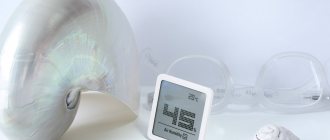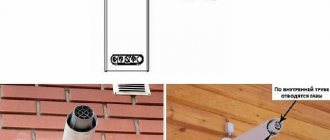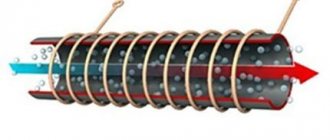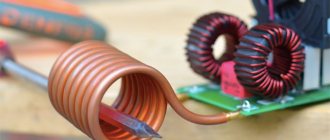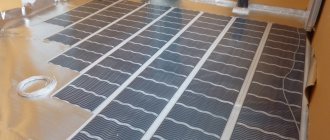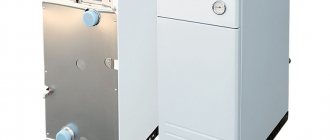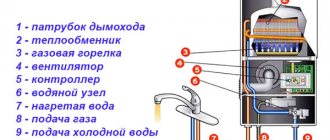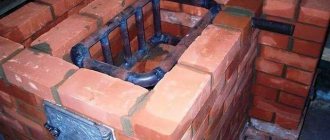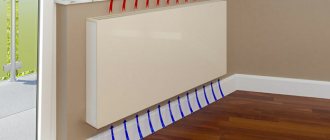The principle of heating materials by induced high-frequency currents has long been used in industry. The method can be used in everyday life to heat water, including for heating a house, since energy transfer occurs more efficiently and with fewer losses. Let's look at what an induction heater is, how it works, what pros and cons it has, and what are the features of making it yourself.
Induction type water heating unit Source by.kotel-electr.ru
Induction heating - what is it, application
Currently, the industry widely uses the method of non-contact heating of workpieces before performing various types of operations - melting, welding, soldering, forging, etc. Its efficiency is so high that it is quickly replacing traditional heating methods. Moreover, due to the peculiarities of energy transfer - without the use of a conductor - losses are minimal, and therefore the method has a high economic indicator.
Induction heating is an increase in the temperature of objects made of electrically conductive materials through the action of an alternating magnetic field in their structure. The technological essence of the procedure is as follows:
- The object that needs to be heated is placed inside an inductor - a conductor twisted in the form of a spiral.
- Next, alternating currents of high strength and different frequencies are sent to the inductor through a special generator.
- As a result, the conductor begins to emit an alternating magnetic field.
- An electrically conductive object is penetrated by this field, as a result of which induced currents arise in it.
- Under the influence of eddy currents, the temperature of the material increases.
The simplest induction heating device Source ytimg.com
This “inductor-object” circuit is essentially a transformer without a core. In it, the inductor is the primary winding, the object is the short-circuited secondary. The magnetic field flows are closed between them through the air. In powerful industrial installations, the inductor conductor itself can become very hot, so to ensure safety, a cooling system is connected to it.
The principle of induction heating is widely used in a wide variety of fields:
- Non-contact welding, melting and soldering of ultra-high purity.
- Heat treatment and bending of elements and assemblies in the automotive industry.
- Creation of experimental samples of alloys.
- Jewelry making.
- Hardening of products on the surface.
- Heat treatment of small-sized parts that are not accessible to plasma and arc.
- Heat treatment and hardening of elements of complex shapes.
- Disinfection of devices and instruments in medicine.
Instantaneous water heater is one of the most commonly used applications of induction heating in the home Source equipmaster.ru
On a note! The non-contact heating method has also found wide application in the manufacture of household heating devices, especially for water. However, in price, such models are significantly superior to traditional analogues operating on heating elements. Therefore, with sufficient experience, you can make them yourself.
Depth options
There are 2 definitions of level - low and high. In the first case, the top layer of water is located at a level of 2 meters and below from the surface. At this level, there are no problems with construction and excavation work - the absorption capacity of the soil is high.
If high groundwater is detected, then any work in the soil becomes more complicated. The main problems are the inability to dig a “dry” pit, problems with pouring concrete, laying bricks, and securing wastewater treatment plants.
If the GWL is high
In case of high groundwater levels, the following problems may arise:
- Difficulties with organizing the sewer system.
- Impossibility of creating basements.
- Problems with choosing and installing a foundation.
- Mold in the house.
- Difficulties with laying any underground communications.
- Soil heaving.
Operating principle of the heater
The mechanism for generating heat in household electrical appliances of this type is based on the same law on which industrial installations operate. However, the scheme of their work has its own characteristics. First of all, they concern the device. Thus, a household induction instantaneous water heater consists of the following main elements:
- An inductor is a coil of copper wire. When a current passes through it, a magnetic field is formed, under the influence of which the electrically conductive material of the heater is heated.
- A generator is a converter of stable household current into a high-frequency flow required in terms of power.
Operating principle of an induction water heater Source vinteplo.ru
See also: Catalog of companies that specialize in engineering systems (heating, water supply, sewerage and others) and related work
- The heating element is a metal pipe through which a water flow is passed to produce heating. The heater simultaneously functions as a cooler for the inductor, thereby providing it with stable operating characteristics and durability.
The generator converts the current from normal to high-frequency and supplies it to the coil. The wire winding produces a magnetic field. The tube heater located inside it heats up and transfers heat to the water flow passing through it. Due to the absence of direct contact during the transition from one type of energy to another, losses are minimal. The efficiency of such electric heaters reaches 98%.
Reference! An induction boiler works according to a similar scheme discussed above, which is an economical, efficient and durable heater for the home. Only instead of a tube, a heat exchange circuit is placed in the inductor, passing through which a special coolant is heated and distributed over all radiators of the living area.
Design and principle of operation of an induction boiler for heating Source oboiman.ru
Large storage systems
We found out what the main disadvantage of the “pipe-in-pipe” water heating element is. Indirect heating takes too long. Since increasing heat transfer is difficult, you can use a larger container to heat water. Then you can “conjure” the heat exchanger. The best option in the illustration: a coil inside a wide body.
The design is a tank of the required capacity (50, 100, 200 liters), inside of which there is a coil (the longer, the more effective the heating). The heat source does not matter: usually it is the room heating circuit. The water in the sanitary (internal) tank warms up quite quickly. The only problem is the uneven distribution of heat. A “cold” area remains at the bottom of the container. Despite the correct selection of heated water (receiving pipe from above), the cold area does not allow the entire volume to warm up.
When making it yourself, it is recommended to use a stainless steel tank and a copper coil. The additional costs will be offset by the high efficiency of the system.
Moreover, materials are not in short supply. The tank will fit from an old activator-type washing machine. A copper tube is sold at any plumbing store.
Another option: “tank in tank”. If you are faced with the question of how to make a boiler with your own hands, take a closer look at this diagram.
The internal container (in which indirect heating will occur) is selected with corrugated walls (preferably). This means there is a larger heat exchange area. And the primary heating water flows through an external point. If you cooled a pan of hot compote in a bowl of cold water, the principle of operation of the heater is clear.
Of course, such a system is more difficult to implement, but the efficiency will be higher.
Advantages and disadvantages
The advantages of a household water heater of this type are as follows:
- Long service life. The average warranty period for most manufacturers is 30 years. At the same time, the installation does not require serious maintenance and repair with the replacement of main elements throughout the entire period of operation. Preventative cleaning is carried out no more than once every 7-9 years.
- Economical energy consumption. To produce the same amount of heat, in comparison with varieties operating on traditional heating elements, 30-40% less energy is spent.
- No scale. The specific mechanism of operation of the device eliminates the formation of scale on the working elements of the installation. In addition, when the device is turned on, it vibrates slightly, which is also a good protective factor against the build-up of various types of deposits on its internal parts in contact with water.
- Minimal risk of leaks. Non-contact heating technology eliminates the factors of destruction - when metal elements quickly rust under the influence of heat and dampness.
An induction water heater is reliable, durable and economical Source rusolymp.ru
Customer Reviews
Andrey, Moscow : I live in St. Petersburg, I purchased a locally produced heater. It works properly, with one exception: the machine regularly knocks out. What's the matter - I haven't figured it out yet. But the savings on electricity are obvious. I specifically checked meter readings and accounts. In general, it is an interesting technology, but it is not yet familiar and therefore sometimes raises questions. It is not entirely clear how to use them correctly, what can be done and what cannot be done.
Marat, Moscow : I have had this heater for 2 years now. The savings on electricity are obvious. There were no breakdowns during this time. Plus, with a water heater using a heating element, I always had to look for a suitable anode to replace the failed one. No such problems arise here. And yet, despite all the advantages, I think that its cost is incredibly overpriced. The design is simple, there are no complications or expensive parts.
Features of self-production
In order to make an induction heater, you must have experience in electrical work and assembling homemade electrical appliances, as well as skills in processing metal and other materials and be able to install wiring. Therefore, in their absence, it is better to entrust such work to professionals. In this case, the general algorithm for manufacturing the device consists of the following sequential stages:
- Making a heater. As a rule, a section of thick-walled metal pipe with adapters at the ends is used, enclosed in a heat-resistant plastic tube of a larger diameter.
DIY heater
Sometimes an induction water heater is not suitable for heating; in this case, you can use other heating methods. A popular quick way to heat a room is a heater or duct heater.
To make a heater you will need:
- Several sheets of stainless metal for the body of the device.
- Copper pipe (should be approximately half an inch in diameter) used in the heat exchanger.
- Duct fan powered from a household network.
- Two end valves with couplings or flange connections to integrate the heat exchanger into the space heating system.
- Several springs (usually four are enough) to secure the fan. It is recommended to fasten with springs rather than magnets, for example, because... springs ensure quiet operation.
The process of creating a heater is divided into parts. The first part is marking. On the prepared sheet of metal, you need to mark the dimensions of the body (you will get a marked strip) and the fold lines of the strip. The second part is making the body. The marked strip is cut from the sheet, folded and secured at opposite ends. The front side of the device is made of galvanized sheet; holes are drilled on the front side for air circulation.
The third part is creating a heat exchanger. The copper pipe is closed on one side with a plug, then sand is poured into the pipe and the pipe is bent. After bending, you can get rid of the sand. The fourth part is connecting the heat exchanger. Two holes are made on the side of the heat exchanger for a copper pipe, threads for couplings are made at the ends of the pipe, and a Mayevsky tap is soldered into the upper point of the heating element. Then the heat exchanger is inserted into the housing and screwed with nuts. The fifth part is installing the fan. Holes are drilled in the corners of the case, springs are fixed in them, the fan is placed in the case so that the springs are spaced apart at an equal distance. The sixth part is installing the device. The heater is connected to the heating system using couplings and taps. The heater is placed on the wall, with a gap of 10 cm between the wall and the device. You can make a water heating element with electricity yourself.
Video description
Video example of making an induction heater:
- Creation of an inductor. An insulated copper wire with a cross-section of about 1-1.5 mm2 is tightly wound around the tube. The number of turns must be at least 90.
- Selecting a suitable alternator. The simplest and most affordable way is to use an inverter from an appropriate welding unit.
- Connecting the heater with the inductor to the water supply or heating pipe.
- Connecting the inductor to the network. The contact wires from the coil are connected to the positive contacts of the inverter.
- Power supply. Rectifier diodes are installed at the terminals. Without them, the voltage of the supplied current will be supplied rectified, and the coil will function as an electromagnet rather than an inductor.
- Turning on and checking the operation of the device.
Note! A self-made heater, unlike factory-made analogues, is not equipped with a protection and control system. Therefore, before turning it on, you must make sure that the heating element is filled with water.
Induction boiler for heating a house - comparison with a boiler using heating elements
May 16, 2012 Electric heating of the house
Greetings, reader of my site!
The topic of heating a house using electric boilers is very close to me, which I have repeatedly told you about, both on the basis of homemade electric boilers , made with my own hands , and factory-made boilers, for example, a very high-quality electric boiler Proterm , manufactured in Slovakia.
And recently, purely by chance, I came across on the Internet the use of the properties of electromagnetic induction in a household electric boiler.
This has been used in production for a long time - for example, metal is melted in induction furnaces. But the application in everyday life is interesting.
I was very interested in this information. We are talking about an induction electric boiler where an inductance coil is used as a heating element.
By the way, a similar device is used in modern induction household electric stoves, you can read more in Wikipedia
Of course, I immediately started digging for information on the Internet, what kind of induction heater is this, what is the principle of its operation, do they have an advantage over electric boilers using heating elements?
It turned out that everything was not as simple and rosy as it seemed...
Briefly about the main thing
Induction heating is based on the ability of an alternating magnetic field to increase the temperature of objects made of electrically conductive materials. Heating is carried out in a non-contact manner and is characterized by high performance and low energy losses. For this reason, the method is widely used in various fields - melting, welding, soldering of metals, heat treatment of components and elements in production, disinfection of instruments in medicine.
The same principle applies to the operation of a domestic water heater. The heating element through which the water passes is placed in an inductor coil. When a high-frequency current is applied, an alternating magnetic field is generated, heating the metal heater. Among the main advantages of such devices are:
- Durability.
- Economy.
- No scale.
- Leak-free operation.
- Natural convection.
Disadvantages are associated with the release of heat into the surrounding space, the need for a stable power supply, constant monitoring of performance characteristics, operating noise and harmful radiation. When manufacturing the device, you must follow the instructions and have sufficient experience.
Equipment advantages
An induction-type room heating device has its advantages:
- requires minimal investment;
- has a high efficiency;
- you can assemble such equipment yourself, at home;
- the efficiency factor is almost one hundred percent. The device loses almost no heat during heating;
- usually when heating heating elements or boilers form scale in the system. In this type of heater, there is no such problem;
- when heated, it does not emit any harmful substances, which means it has an environmentally friendly operating process;
- You can pour not only water into the system, but also antifreeze and oil;
Induction heater: operating principle
- does not require constant equipment maintenance;
- Even a non-professional can handle the installation and operation does not require special knowledge;
- The boiler is very well protected from a fire safety point of view. The electrical component is quite reliable and does not fail;
- this type of heater can be used in conjunction with others;
- can operate on both direct and alternating current;
- operation is possible for twenty years;
- The device is very well suited for cottages or private buildings.
But even with so many advantages, the boiler has disadvantages:
- the price of such a device is quite high. And it is unlikely to pay off within 1 – 2 heating seasons;
- there is a need for a constant electrical power supply;
- the device is heavy;
- Installed only with a closed heating system.
But if you decide to replace your wood stove or boiler with a heater of this type, you can immediately get rid of several problems:
- there will no longer be a burning smell in the home;
- there is no soot when lighting the boiler;
- there will be no need to remove soot and ash;
- There will be no need to purchase firewood or coal.
In addition, there is no need to take up space or a special room for storing solid fuel.
https://youtube.com/watch?v=k6fXWhDlyXc
Working diagram
The heater includes the following components:
- An inverter unit designed for a voltage of 220…240 V, with a current of at least 10 A.
- Three-wire cable line (one wire is ground) with a normally open switch.
- Water cooling system (it is highly advisable to use water purification filters).
- A set of coils that differ in internal diameters and lengths (for limited volumes of work, you can get by with one coil).
- Heating block (you can use a module with power transistors produced by Chinese companies Infineon or IGBT).
- Damper circuit with several Semikron capacitors.
The high-frequency oscillation generator is the same as that of the basic inverter
It is important that its operational characteristics fully comply with those indicated in the previous sections
After assembly, the unit is grounded and the heating induction coil is connected to the inverter power supply using connecting cables.
Approximate operational capabilities of a homemade metal induction heater:
- Highest heating temperature, °C – 800.
- The minimum power of the inverter is 2 kVA.
- PV switch-on duration, no less than 80.
- Operating frequency, kHz (adjustable) - 1.0...5.0.
- Internal diameter of the coil, mm – 50.
It should be noted that such an inductor will require a specially prepared workplace - a waste water tank, a pump, and reliable grounding.

